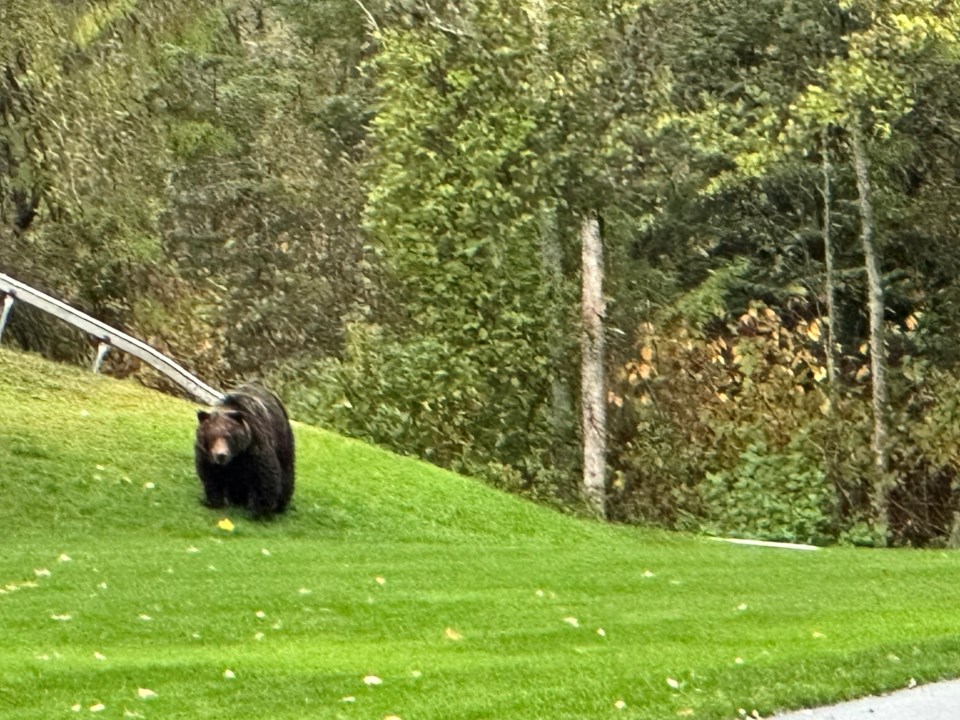A grizzly bear hanging around the soccer fields at Whistler’s Myrtle Philip Community School this week is causing anxiety for parents—but the BC Conservation Officer Service says the bear’s presence alone doesn’t pose an imminent risk.
“This bear has not exhibited any aggressive or conflict behaviour and is feeding on natural foods. We ask the public to give the bear space in the hopes it moves on from the area,” the COS said in a release on Oct. 16.
“To help ensure this bear—and other wildlife—does not linger and create conflicts, we are asking the public to ensure their attractants are securely stored. Residents can help us by inspecting their yards and properties and ensuring any attractants, such as garbage, pet food or birdseed, are securely stored. Please ensure barbecues are clean and fruit is removed from trees and the ground.”
With the grizzly still in the area, Whistler’s Balsam Park and the adjacent soccer fields at Myrtle Philip Community School are closed.
“Additionally, the lower section of the trail ‘Cut Yer Bars,’ which runs parallel to the lower Myrtle Philip fields connecting to Balsam Park, will be closed to reduce the risk of surprise encounters with the grizzly bear,” the Resort Municipality of Whistler (RMOW) said in a Facebook comment on Oct. 11.
The closures will remain in place until further notice. If you encounter a bear, give it space, back away slowly from the area and speak in a calm, firm voice.
The grizzly was first spotted at Nicklaus North Golf Course over the Thanksgiving weekend, prompting a closure there as well.
Earlier this summer, a 300-pound female grizzly was tranquilized and relocated in early June near the Fairmont Chateau Whistler.
It’s unclear if it is the same grizzly in both instances.
From Jan. 1 to July 5, the COS received 30 reports of grizzly encounters in the Whistler area, and encounters have doubled in recent years.
The increased grizzly sightings—and the “unusual” sighting of a grizzly in the valley this fall—are positive signs of grizzly recovery in the region, according to the Grizzly Bear Foundation.
“This is a critical time of year for bears to bulk up in preparation for hibernation, and anecdotally there seems to be a poor supply of berries right now,” said Taylor Green, outreach and communications manager with the Grizzly Bear Foundation. “It’s super important to ensure this bear moves on and makes it to winter denning without accessing any human food sources.”
Fortunately, as a Bear Smart community, Whistler already has many of the tools and knowledge needed to coexist with grizzlies.
“A big challenge now is the shift in mindset. We need to wrap our heads around the idea that grizzly bears are returning to Whistler, and that coexistence comes with a responsibility on our part,” Green said. “In sharing space with wildlife, it needs to be a give-and-take. It’s all part of a bigger picture of healing our relationship with nature. So what support does the community need? This is an important discussion as Whistler prepares for ongoing grizzly bear recovery.”
The COS asks the public to take precautions in case of wildlife encounters.
“Do not approach bears to take pictures, confront bears or feed bears. Leash your pets, travel in groups and consider carrying bear spray. For more tips, please visit WildSafeBC,” the release said.
The COS is in regular contact with municipal and law enforcement partners, and any urgent public safety information will be immediately shared via online social channels and with partners.
Officers continue to monitor bear activity in the area, and will respond as necessary. Bear conflicts and aggressive bear behaviour can be reported 1-877-952-7277.




